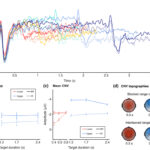Zhang, B., Weidner, R., Allenmark, F., Bertleff, S., Fink, G. R., Shi, Z., & Müller, H. J. (2021). Statistical learning of frequent distractor locations in visual search involves regional signal suppression in early visual cortex. In bioRxiv (p. 2021.04.16.440127). https://doi.org/10.1101/2021.04.16.440127
Abstract
Observers can learn the locations where salient distractors appear frequently to reduce potential interference – an effect attributed to better suppression of distractors at frequent locations. But how distractor suppression is implemented in the visual cortex and frontoparietal attention networks remains unclear. We used fMRI and a regional distractor-location learning paradigm (Sauter et al. 2018, 2020) with two types of distractors defined in either the same (orientation) or a different (colour) dimension to the target to investigate this issue. fMRI results showed that BOLD signals in early visual cortex were significantly reduced for distractors (as well as targets) occurring at the frequent versus rare locations, mirroring behavioural patterns. This reduction was more robust with same-dimension distractors. Crucially, behavioural interference was correlated with distractor-evoked visual activity only for same- (but not different-) dimension distractors. Moreover, with different- (but not same-) dimension distractors, a colour-processing area within the fusiform gyrus was activated more when a colour distractor was present versus absent and with a distractor occurring at a rare versus frequent location. These results support statistical learning of frequent distractor locations involving regional suppression in the early visual cortex and point to differential neural mechanisms of distractor handling with different-versus same-dimension distractors.




